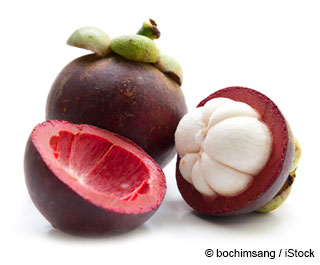Magnificent Mangosteens
Botanical name: Garcinia mangostana

Mangosteens are somewhat unfamiliar in North America, though they're common in the southeastern parts of both Asia and Africa. Cultivation of this fruit is mainly focused in four countries: Indonesia, Malaysia, Thailand and the Philippines.1
A mangosteen is easily recognizable by its distinct dark purple or red-purple color and the prominent calyx at the stem. The rind is thick, taking up about 1/2 inch of the whole fruit's diameter. It is considered to be one of the most nutrient-dense parts of the fruit, and while it isn't edible, it's often processed as medicine.2
The mangosteen's flesh is often divided into four to eight segments of soft, white wedges. These have an acidic but nonetheless luscious flavor, which makes mangosteen a good dessert.3 Because mangosteen trees are acclimated to tropical climates, they do not fare well in other regions. From Asia, mangosteens were transported to both North and South America, where only a handful of seedlings survived their first years.4
Health Benefits of Mangosteen
Mangosteens have a long list of benefits, including anti-inflammatory, antioxidant, neuroprotective and anti-obesity properties.5 For years, they have been used in Southeast Asia as a medicinal plant known to relieve urinary disorders, dysentery and gonorrhea.6
Nutritionally speaking, mangosteens contain considerable amounts of calcium, magnesium and phosphorus, which are important in maintaining skeletal, muscular and organ health. These fruits also have a surplus of potassium, the mineral that helps control heart rate and regulate blood pressure, which in turn aids in lowering the risk of coronary heart disease and stroke.7
New research now suggests that xanthones — a powerful antioxidant found almost exclusively in mangosteen — have properties that fight pain, allergies, infections and skin disorders.8
Despite these benefits, remember to consume mangosteen in moderation, as it contains fructose, which may be harmful to your health in excessive amounts. The U.S. Department of Agriculture (USDA) only has information regarding canned mangosteen, but it can give you an idea on what to expect regarding nutrition:9
Mangosteen Nutrition Facts
Serving Size: 1 cup (196 grams), canned, drained
| Calories |
143 kcal |
|
| Total Fat |
1.14 g |
|
| Saturated Fat |
|
|
| Trans Fat |
|
|
| Cholesterol |
|
|
| Total Carbohydrates |
35.1 g |
|
| Dietary Fiber |
3.53 g |
|
| Protein |
0.804 g |
|
| Calcium 23.5 mg |
Iron |
0.588 mg |
Studies Done on Mangosteen
Mangosteens have been used in numerous anticancer studies, achieving positive results. A 2012 study from BMC Complementary Alternative Medicine showed how mangosteens significantly slowed the growth of cancerous colorectal tumors. This is mainly due to the xanthones found in mangosteen, which promoted cytotoxicity in the cancer cells.10 While another 2012 study in Carcinogenesis showed alpha-Mangostin's mechanism against prostate cancer by suppressing tumor growth.11
A 2017 study from Food and Chemical Toxicology claimed that this fruit may be used as a source for future medications targeting chronic and degenerative diseases because of the different pathways that mangosteen xanthones seem to have an influence on.12
Mangosteen Healthy Recipes:
Mixed Spring Greens With Citrus Vinaigrette

|
Ingredients:
|
|
✓ Mixed spring greens or spinach
|
✓ 2 mangosteens, peeled and segmented
|
✓ ¼ cup chopped almonds, toasted
|
✓ Himalayan sea salt and freshly ground black pepper to taste
|
|
Champagne-Citrus Vinaigrette:
|
|
✓ 1 tablespoon raw apple cider vinegar
|
✓ 1 tablespoon freshly squeezed mangosteen juice
|
✓ ½ teaspoon Dijon mustard
|
✓ 1½ teaspoons freshly grated orange peel
|
|
✓ ½ teaspoon raw honey
|
✓ ½ teaspoon each of Himalayan sea salt and black pepper
|
✓ 1/3 cup organic coconut oil
|
|
Procedure:
- Use a sharp knife to cut around the outside middle of the mangosteen, about half-an-inch deep. Using both hands, use your thumbs to pry open the fruit and remove white fruit segments (not unlike an orange) at center.
- Spread chopped almonds in a single layer on a cookie sheet and toast lightly in a 350-degree Fahrenheit oven (about five minutes). Combine all but the oil in a small bowl. Whisking constantly, drizzle in oil until smooth. Add salt and pepper to taste. Place spring greens in a large salad bowl, toss with vinaigrette and sprinkle with chopped almonds.
Note: Makes 4 servings.
(Adapted from Dr. Mercola's "Healthy Recipes for Your Nutritional Type")
Mangosteen Fun Facts
Due to its rarity in the West, Queen Victoria was rumored to grant knighthood to anyone who can bring her a mangosteen fruit. This is also the reason why mangosteen is often referred to as the "queen of the fruits."13
Summary
From the exotic reaches of Malaysia, the Philippines, Sri Lanka and Indonesia, mangosteens may be unfamiliar to many in the U.S. This glossy purple fruit (with a few different colored varieties) is low in calories, high in fiber and contains powerful antioxidants, including xanthones. These and other phytonutrients neutralize harmful free radicals and help the body fight infection. Studies have shown that mangosteens have the potential to slow the growth of cancer cells and may even be chemopreventive.
If you've never tried this delectable fruit, try mangosteen segments in your next garden salad. You might discover a new favorite.